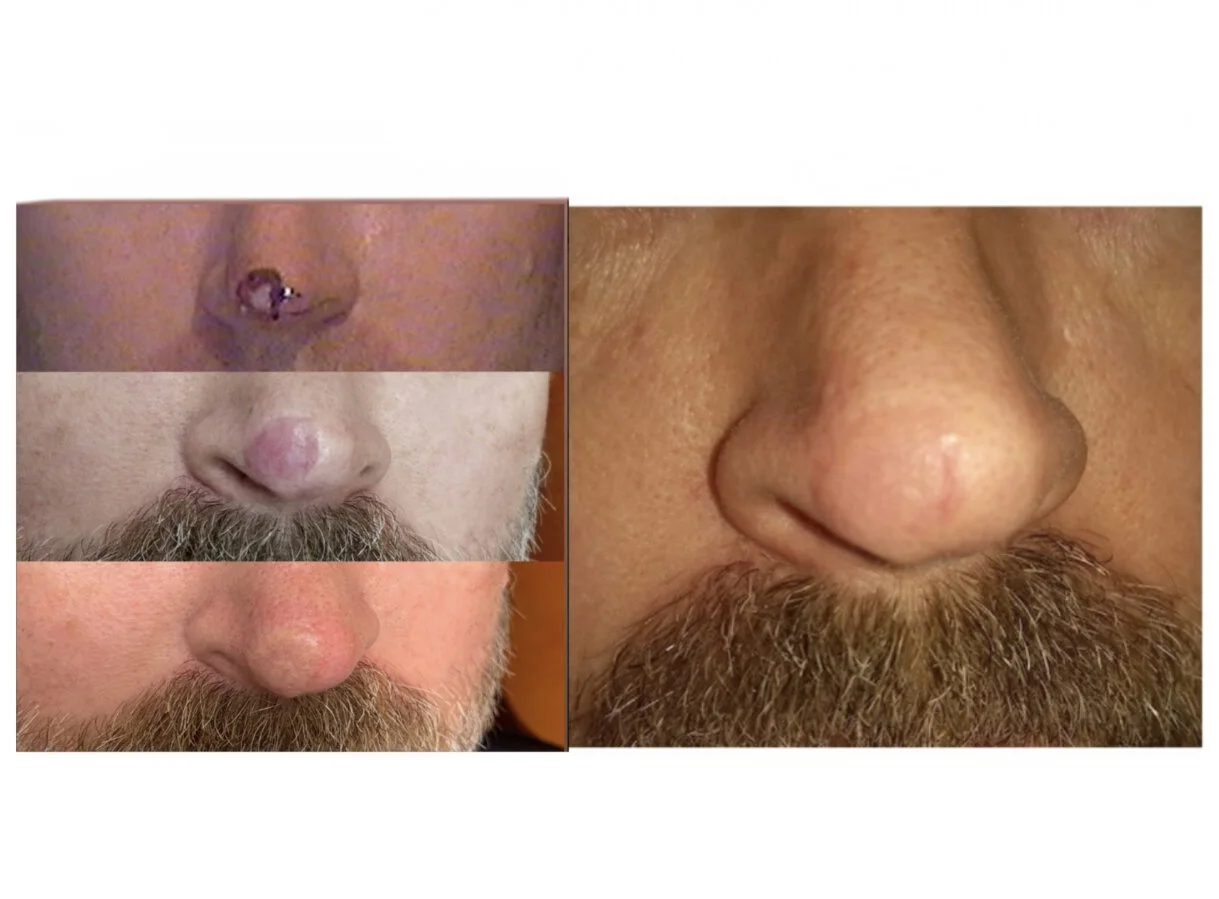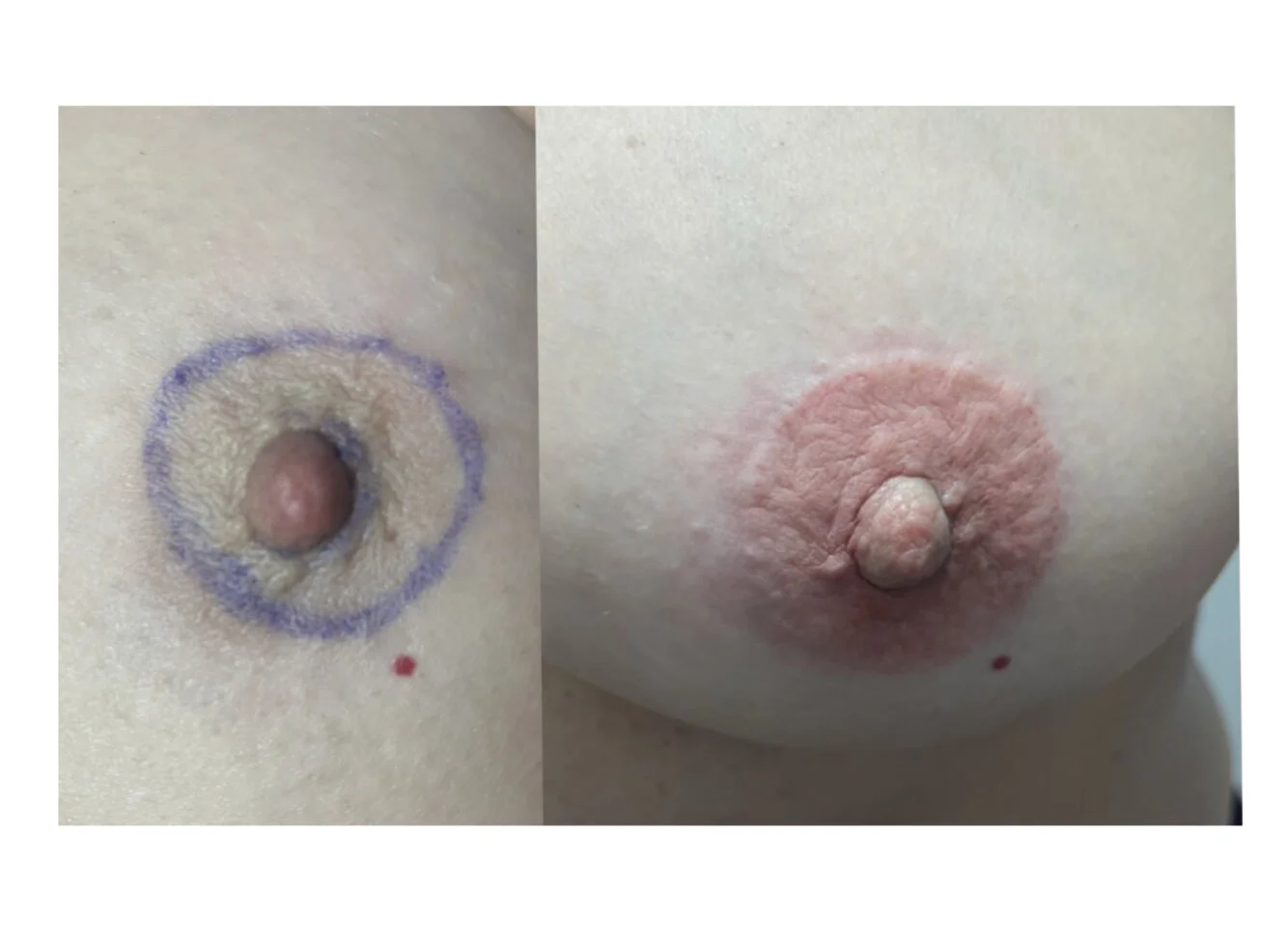“ I was diagnosed with a type of skin cancer called Basal Cell Carcinoma. Basal Cell was the result, in my case, of cumulative Sun exposure over a period of years. The medical treatment for this condition was a surgery called ‘Mohs surgery’, which involves removing the cancerous cells, then testing the area to determine if additional cancer cells are present. If so, the procedure is repeated until all cancerous cells have been removed.
This procedure resulted in removal of a significant amount of skin at the tip of my nose. Afterwards, a skin graft was used to cover the affected area, but the graph did not exactly match the surrounding skin color and texture. While I was very thankful that the procedure and skin graft were successful, I became self-conscious and social situation due to the obvious scarring in such a conspicuous place. The tattoo added color that needed the redness from the original skin graphing.”
— Medical Tattoo Customer
Let us help you on your road to recovery
-

Scar or Skin Micro Pigmentation
This process is also called Corrective Pigment Camouflage, Corrective Camouflage, Skin Repigmentation, Scar Camouflage, Skin Camouflage, Camouflage Tattooing, and Skin Color Tattooing and both men and women can benefit from scar camouflage procedures.
Facial burns
scar discolorations
vitiligo
stretch marks
and other blemishes
This cosmetic micro-pigmentation procedure involves embedding an organic pigment under the skin to add permanent color, camouflaging the appearance of targeted area.
What to Expect From Scar Camouflage
Prospective clients often wonder if we can help reduce the appearance of a scar or area they are dissatisfied with, Yes!
However, there’s a lot more to it than that. It’s essential to understand what we can and can’t do. Make sure you have a consultation with us first so you have the proper expectations from the beginning.
Here’s what you should know about scar camouflaging.
We can improve the appearance of scars just about anywhere on the body.
If you look very closely, our skin is not all one uniform color; it’s a mix of colors. We use a technique, which uses a blend of colors to more closely match the skin’s natural color patterns.
We add pigments matched to your particular skin to make the scar color blend with the surrounding skin. We also use specialized techniques to mask the scar’s appearance further.
What to expect:
Although Scar and Skin camouflage can reduce the appearance of your scar, it’s essential to understand that scars are long-lasting, and no scar will ever be completely invisible. Every scar is different: body location, size, shape, color, the appearance of depth, and so on. Some scars require only a single treatment, and others take multiple sessions. Results are cumulative and may take four to six weeks to develop fully.
-

Areola Repigmentation
Areola Repigmentation may also be called Areola Tattooing, Areola Micropigmentation, Areola Pigmentation, Areola Recoloring, Areola Restoration, or Areola Simulation.
These procedures help improve the appearance and self esteem of both women and men who have undergone breast surgery. Areola Repigmentation techniques can “create” an areola after breast reconstruction, minimize the appearance of scars, or restore an areola to a more natural looking color and shape.
3D Areola-Nipple Complex Simulation (Full nipple and areola): This procedure is to create the appearance of an areola or helps the reconstructed nipple to match the natural breast. Areola complex simulation can be achieved with or without a nipple button created by the surgeon.
Areola Scar Camouflage: Many breast operations produce scarring around the edge of the areola. A scar’s appearance can be softened, blended, or reduced by tattooing the areola scar using corrective pigment camouflage techniques.
Areola Size or Color Adjustment: The color of an areola can be darkened, balanced, or enhanced with tattooing. The process helps women who have discolored, lightened areolas or are self-conscious about their areola color or size may choose this procedure to adjust their appearance.
What’s the difference between Areola, Nipple, 3-D Areola and Camouflage Tattoos?
Try not to get caught up in terminology vs techniques. We consult with each of our guests to determine what approach and technique to you and best fits your needs.
Can I still get tattooed if I had nipple reconstruction?
Yes, although there are occasions when the pigment does not take well on the reconstructed nipple. The reconstructed nipple as well as the area around it can still be tattooed, but follow up visits may be needed to ensure adequate pigment retention in that area.
-

Scalp MicroPigmentation
Scalp Micropigmentation goes by many names: SMP, scalp tattoo, hair tattoo, and hair pigmentation. Scalp Micropigmentation (or SMP for short), is a non-surgical, superficial cosmetic tattoo that gives the illusion of a close buzz cut hairstyle on a bald head or density to a thinning crown.
The procedure can also be used to:
SMP for men
SMP for women
Receding hairline
Baldness
Thinning hair
Genetic hair loss
Hair loss after illness such as lupus and cancer
Birthmark blending
Hair transplant scar camouflage from a previous hair transplant
SMP for dark and light skin
Adding density to longer hair
conceal scars from hair transplantation
hide the visual impact of burns or scars on head.
The advantages of this procedure is that the hairline can be adjusted or touched up with relative ease with the uses pointillism or a dotting technique. After just a couple visits, you’ll will leave with a scalp tattoo that looks just like a fresh buzz cut.
Who is SMP suitable for?
The SMP procedure is suitable for men and woman who are losing hair, have longer hair, shorter hair or have gone bald. Performing a hair tattoo is a very skilled process.
Does hair tattooing look realistic?
Scalp micropigmentation looks super impressive and very realistic. SMP doesn’t look fake. Your aim is to have a natural look of a natural hairstyle / hairline.
Having a hair tattoo for hair loss is the world’s fastest growing solution to people losing their precious hair and baldness.
Medical Tattooing is often the last step in the puzzle, after going through things like battling cancer, alopecia , vitiligo or hair loss. It can really give clients the confidence and potential to close the chapter on a difficult time.
Let us help you along this journey to recovery!